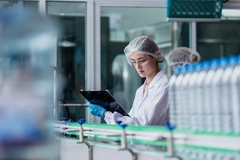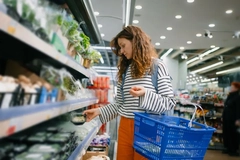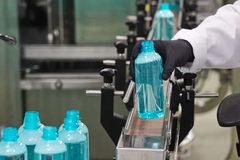Metal packaging demand surges among geopolitical instability and energy supply shortages

24 Jul 2024 --- The packaging industry competes with many other sectors for metal supplies, leaving the industry with potential supply bottlenecks brought on by mounting geopolitical instability and energy supply shortages, according to Ásdís Virk Sigtryggsdóttir, chief commercial officer at Iceland-based metal company DTE.
The packaging industry uses huge quantities of metal, especially aluminum and steel. Metal packaging can be found in consumer goods such as drink and food cans, foil products and aerosol cans. It is used extensively in wholesale and industrial packaging.
“With energy prices high in Europe due to the ongoing war in Ukraine, troubles in the Middle East and high demand worldwide, there are significant cost savings to be made for aluminum producers,” Sigtryggsdóttir tells Packaging Insights.
Specifically, there has been a substantial drop in aluminum production in European countries such as Germany due to higher energy prices brought about by the war in Ukraine, and prices of metal for packaging are 57% higher than in Q1 2020 due to destabilizing factors such as ongoing attacks on shipping vessels in the Red Sea.
LIBS technology
Laser-induced breakdown spectroscopy (LIBS) is a widely used technique for elemental analysis, first developed by the US Army between 2000 and 2010.
A handful of specialist developers, such as DTE, have applied it to the chemical composition analysis of molten metals. This can help the industry develop methods of improving material quality and lowering costs.
 DTE performs elemental analysis directly from liquid metal utilizing DTE’s LIBS technology.“Even minor changes in the chemical composition of metal can radically alter its properties in terms of strength, melting point and corrosion resistance,” explains Sigtryggsdóttir.
DTE performs elemental analysis directly from liquid metal utilizing DTE’s LIBS technology.“Even minor changes in the chemical composition of metal can radically alter its properties in terms of strength, melting point and corrosion resistance,” explains Sigtryggsdóttir.
“For example, pure aluminum is quite weak, but alloying it with copper, magnesium or manganese can increase its strength while the addition of silicon reduces its melting temperature.”
Knowing exactly what other elements are present or absent from a batch of molten metal allows metal with appropriate qualities to be produced for a wide range of applications, she adds.
Earlier this year, Christopher Bradford, marketing director of AkzoNobel’s Industrial Coatings business, told us that one of the biggest challenges for metal can producers is meeting the European Food Safety Authority’s desire to remove bisphenols as a packaging barrier for F&B products.
Recycling advantages
Melting and alloying aluminum uses a lot of energy, which increases for every minute it must be kept in a molten state. “Therefore, there are considerable benefits to ensuring that the correct specifications are met as quickly as possible,” says Sigtryggsdóttir.
“The ability to analyze molten metal in real-time opens numerous opportunities for process improvements, allowing for immediate adjustments and optimization of the production process, eliminating off-spec production, boosting efficiency and throughput, reducing costs and the carbon footprint of the operations.”
These savings can, in turn, be passed on to downstream buyers in the packaging industry.
“Real-time analysis of molten aluminum by utilizing LIBS offers significant advantages for recyclers — impurities mixed in from previous uses can affect scrap composition down the line,” continues Sigtryggsdóttir.
“When it comes to food packaging, this is particularly pertinent, as standards for certain toxic elements, such as lead, arsenic and cadmium, are incredibly stringent, and rightly so.”
Furthermore, recyclers can optimize material use based on the target composition and the available materials, making sure that they stay within tight specifications while utilizing the lowest grade of scrap possible and minimizing the use of primary aluminum.
Thereby recyclers can minimize the carbon footprint of the production and maximize the use of scrap in the final product, without sacrificing safety or quality. Analyzing molten metal in real-time opens numerous opportunities for process improvements.
Meanwhile, Innova Market Insights data indicates that using metal packaging with recyclable claims in F&B launches has grown by 2% annually from April 2019 to March 2024.
Boosting supply
Utilizing LIBS for chemical composition analysis offers savings in energy usage and, therefore, greater affordability and availability for downstream customers in the packaging industry, while its use in the recycling can cut the need for new and more costly virgin metals and increase the overall supply available, asserts Sigtryggsdóttir.
“Currently, LIBS is still new technology when it comes to analyzing molten metals, but it has already found use with major manufacturers such as Century Aluminium and Emirates Global Aluminium, as well as with the world’s largest recycler of aluminum, Novelis, in whose plants DTE has already installed equipment. LIBS’ applications go far beyond aluminum.”
“In the future, the technology will be rolled out into other metals, offering the same advantages,” she adds.
Furthermore, LRS, the US’ fifth-largest independent waste diversion, recycling and portable services provider, and Everest Labs partnered to boost aluminum can recovery at its new recycling facility in Chicago.
We spoke to John Sliwicki, executive vice president for the Central Region at LRS, and Scott Breen, senior vice president of sustainability at CMI, to get the scoop.
By Natalie Schwertheim











